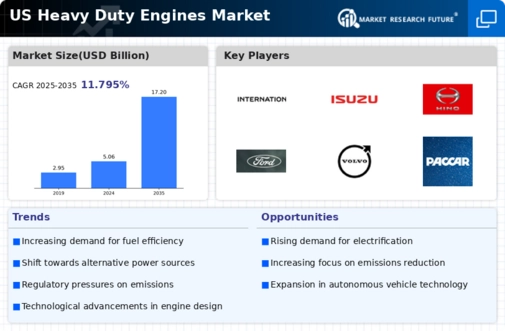Infrastructure Development and Investment
Infrastructure development plays a pivotal role in driving the heavy duty-engines market. The US government has committed substantial investments in infrastructure projects, including highways, bridges, and public transportation systems. This investment is expected to boost demand for heavy duty vehicles, which in turn drives the need for robust engines capable of supporting these applications. According to the Federal Highway Administration, funding for infrastructure projects is projected to increase by 15% over the next five years. As these projects progress, the demand for heavy duty-engines is likely to rise, as they are essential for construction, logistics, and transportation sectors. This trend indicates a positive outlook for manufacturers in the heavy duty-engines market, as they align their production capabilities with the growing infrastructure needs.
Rising Demand for E-commerce and Logistics
The surge in e-commerce and logistics activities is significantly impacting the heavy duty-engines market. As online shopping continues to grow, the demand for efficient transportation and delivery systems has escalated. Heavy duty vehicles are essential for moving goods across long distances, and this trend is expected to drive engine sales. According to the US Census Bureau, e-commerce sales have increased by over 30% in the past year, leading to a corresponding rise in demand for heavy duty trucks and engines. This shift in consumer behavior necessitates a robust logistics infrastructure, which in turn fuels the heavy duty-engines market. Manufacturers are likely to benefit from this trend as they cater to the evolving needs of the logistics sector.
Focus on Fuel Efficiency and Cost Reduction
Fuel efficiency remains a critical driver in the heavy duty-engines market, as operators seek to reduce operational costs. With fluctuating fuel prices, the emphasis on developing engines that offer better fuel economy is paramount. Manufacturers are investing in research and development to create engines that not only comply with emission standards but also maximize fuel efficiency. Reports indicate that engines with improved fuel economy can reduce fuel costs by up to 15%, which is a significant incentive for fleet operators. This focus on cost reduction is likely to shape purchasing decisions, as companies prioritize engines that deliver both performance and economic benefits. Consequently, the heavy duty-engines market is expected to evolve in response to these demands, fostering innovation and competition among manufacturers.
Regulatory Compliance and Emission Standards
The heavy duty-engines market is increasingly influenced by stringent regulatory compliance and emission standards set by the US government. These regulations aim to reduce environmental impact and promote cleaner technologies. As a result, manufacturers are compelled to innovate and develop engines that meet these standards, which often leads to increased operational costs. The market is witnessing a shift towards engines that utilize alternative fuels and advanced emission control technologies. For instance, the Environmental Protection Agency (EPA) has established guidelines that require a reduction in nitrogen oxides (NOx) emissions by up to 90% by 2027. This regulatory landscape not only drives innovation but also creates opportunities for companies that can adapt quickly to these changes, thereby shaping the competitive dynamics within the heavy duty-engines market.
Technological Integration and Smart Features
The integration of advanced technologies and smart features is transforming the heavy duty-engines market. Innovations such as telematics, predictive maintenance, and automation are becoming increasingly prevalent. These technologies enhance operational efficiency and reduce downtime, which is crucial for fleet operators. For example, telematics systems can provide real-time data on engine performance, fuel consumption, and maintenance needs, allowing for proactive management. The adoption of these technologies is expected to grow, with estimates suggesting a 20% increase in telematics-equipped vehicles by 2027. This trend not only improves the performance of heavy duty engines but also aligns with the industry's shift towards data-driven decision-making, thereby influencing purchasing decisions in the heavy duty-engines market.






















Leave a Comment